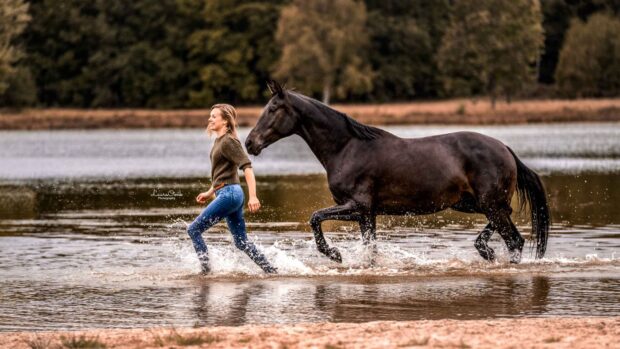In her latest book 'Lungeing and Long Reining', Jennie Loriston-Clarke takes the reader through a step-by-step guide to training, exercising and suppling horses from the ground. Here she looks at tackling some of the problems lungeing can throw up
Lungeing may appear a very straightforward activity but horses can react in many ways and they don’t all walk and trot quietly in a perfect circle as we would like. Many cut in on the circle and then pull out on the opposite side.
In this case you should move towards the horse in a more attacking manner and not retreat to collect up the rein which has become slack as he has moved in on the circle.
You must point the whip at his shoulder and move forwards towards him — almost placing yourself a little in front of him. You should look him firmly in the eye so he knows you are confronting him.
Then stand firm when he tries to pull out on the opposite side of the circle and gently give him a few sharp jerks on the cavesson to make him listen to your voice. After a few rounds like this he will settle down and continue on the circle correctly.
Continued below…

10 training tips that top riders swear by
Turning in
This is when a horse turns in to face the handler.
When inexperienced lungers try to insist on a horse walking when he is first put on the lunge, they often come across this problem. They send him out on the lunge, he trots, they pull on the lunge rein to steady him and he turns in to look at them, wondering what he is to do.
If you find yourself in this situation you have to decide whether the horse is being cheeky or is genuinely confused.
If the latter, keep a fairly firm feel on the lunge rein, walk up to him, turn him into the correct direction and start him off again.
If he continues to turn in, ask an assistant to correct him with a sharp flick with the whip on his upper hind leg while you keep the contact on the lunge rein. Be prepared to move slightly to the inside of the horse as he is driven forward.
If you are lungeing singlehandedly you must ‘attack’ him with an aggressive stance, looking him firmly in the eye and chasing him back out onto the circle again. He must understand that the turning-in behaviour is not acceptable; and if you use a soothing voice when he is good and are careful to keep yourself in a driving position, he will learn to please you.
Turning away
There are a few horses who try to turn away from you when on the lunge.
This can be very dangerous and usually only happens when the horse has been started incorrectly and has got away with this kind of behaviour before, either on the lunge or when being led. A horse never forgets and will try to repeat any ruse that has been successful — and, of course, these horses are always more difficult to change.
If a horse has got into the bad habit of turning away from you, you will have to resort to lungeing with a restrainer bridle or off the bit, via a check rein, to give you more control. In this case, the lunge rein should be threaded through the ring of the snaffle, passed over the head and attached to the bit ring on the other side. This works like a one-sided gag and does not pull across the jaw, which often makes horses lean out on the rein and is not to be recommended.
When lungeing a horse off the bit you must be more careful how you handle the lunge rein and be sure to have a light feel on the rein. If the horse suddenly tries to pull away from you, you must be quick and firm to stop him and turn him back, and then continue lungeing him. Remember that he will try to repeat the performance several times, so don’t get caught out.
A horse usually does the same thing at the same place on the circle, so anticipate his moves and make sure that you are one step ahead of his thinking. After all, it is our superior intelligence which helps us train and ride horses. Horses are simple, biddable creatures by nature; most love to please you and to be your friend.
This extract is taken from ‘Lungeing and Long-Reining’ by Jennie Loriston-Clarke, published by Kenilworth Press and available from the 24 June for £18.95. Visit www.quillerpublishing.com




